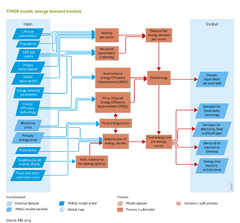Energy demand/Description: Difference between revisions
Jump to navigation
Jump to search
Oostenrijr (talk | contribs) No edit summary |
Oostenrijr (talk | contribs) No edit summary |
||
| Line 5: | Line 5: | ||
In the generic module, demand for final energy is calculated for each region (R), sector (S) and energy form (F, heat or electricity) according to: | In the generic module, demand for final energy is calculated for each region (R), sector (S) and energy form (F, heat or electricity) according to: | ||
{{FormulaAndTableTemplate| | {{FormulaAndTableTemplate|Formula1 Energy demand}} | ||
Equation 1, in which: | Equation 1, in which: | ||
| Line 36: | Line 36: | ||
Demand for secondary energy carriers is determined on the basis of demand for energy services and the relative prices of the energy carriers. For each energy carrier, a final efficiency value (η) is assumed to account for differences between energy carriers in converting final energy into energy services. The indicated market share ([[HasAcronym::IMS]]) of each fuel is determined using a multinomial logit model that assigns market shares to the different carriers (i) on the basis of their relative prices in a set of competing carriers (j). | Demand for secondary energy carriers is determined on the basis of demand for energy services and the relative prices of the energy carriers. For each energy carrier, a final efficiency value (η) is assumed to account for differences between energy carriers in converting final energy into energy services. The indicated market share ([[HasAcronym::IMS]]) of each fuel is determined using a multinomial logit model that assigns market shares to the different carriers (i) on the basis of their relative prices in a set of competing carriers (j). | ||
{{FormulaAndTableTemplate| | {{FormulaAndTableTemplate|Formula2 Energy demand}} | ||
IMS is the indicated market share of different energy carriers or technologies and c is their costs. In this equation, λ is the so-called logit parameter, determining the sensitivity of markets to price differences. | IMS is the indicated market share of different energy carriers or technologies and c is their costs. In this equation, λ is the so-called logit parameter, determining the sensitivity of markets to price differences. | ||
Revision as of 14:54, 1 July 2014
Parts of Energy demand/Description
| Component is implemented in: |
|
| Related IMAGE components |
| Projects/Applications |
| Key publications |
| References |
